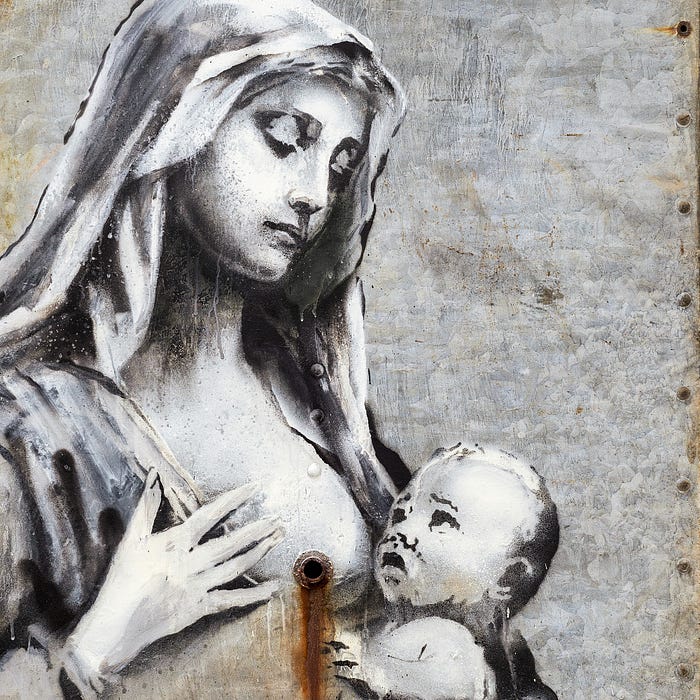Why Did Banksy Sell $22,000 Art for Just $60? The Marketing Genius Behind the Stunt

Share

Banksy, the elusive British street artist, is not just a master of stencil graffiti — he’s also a marketing genius. Despite his anti-establishment stance, he has created one of the most powerful personal brands in contemporary art, blending secrecy, social commentary, and strategic disruption.
In this article, I decide to explore the marketing tactics Banksy has used to transform street art into a global phenomenon, make his work go viral, and challenge the traditional art market.
The Power of Mystery: Turning Absence Into Demand
Banksy’s anonymous identity is his most powerful marketing asset. While most artists strive for recognition, he thrives in secrecy, allowing the mystique around him to fuel public curiosity. The speculation over his identity keeps him in the headlines, ensuring that every new artwork or stunt receives massive media attention.

His anonymity also allows him to maintain an outsider persona, positioning himself as an artist who critiques capitalism and the art world — ironically, making his art even more desirable to collectors.
Scarcity & Exclusivity: The $60 Banksy Experiment
In 2013, Banksy secretly set up a stall in New York’s Central Park, selling original, signed canvases for just $60 each. By the end of the day, only eight paintings were sold, totaling $420 — a shocking contrast to their actual market value of £20,000+ per piece.
Why did he do this? The stunt highlighted how perceived value in the art world is driven by branding, galleries, and hype, rather than the art itself. It also reinforced the idea that Banksy’s work, when not recognized, is just another anonymous street painting — challenging the status quo of the art market.
By stating that the stall was a one-time event, Banksy created an instant scarcity effect — one of the most effective marketing strategies in luxury markets.
Virality & Shock Value: Social Commentary That Travels
Banksy’s work thrives on controversy and cultural relevance. His art isn’t just visually striking — it makes a statement. Whether it’s political satire, critiques of consumerism, or jabs at authority, each piece invites discussion, spreading virally across social media.

Some of his most impactful marketing moments include:
✔ Shredding His Own Artwork: In 2018, his painting Girl with Balloon self-destructed at a Sotheby’s auction just after being sold for $1.4 million, instantly increasing its value.
✔ Dismaland (2015): A dystopian “anti-theme park” that gained massive media attention and positioned Banksy as a cultural disruptor.
✔ Exit Through the Gift Shop (2010): His Oscar-nominated documentary blurred the lines between art, hype, and commercialization, turning the entire street art world into a performance piece.
The Walled Off Hotel: A Marketing Masterpiece
Banksy took his branding to another level by opening The Walled Off Hotel in Bethlehem, dubbed “the hotel with the worst view in the world” due to its location next to the Israeli West Bank barrier. More than just accommodation, it is part art installation, part political statement, and part exclusive experience.

Guests don’t just book a room — they sleep inside a work of art. So far, Banksy, Sami Musa, and Dominique Petrin have customized the guest rooms, with more artists expected to contribute.
As Diane Arbus once said, “To live with an artwork is something different, to glimpse it from the corner of your eye.” Banksy turned this concept into reality — offering an immersive experience where visitors wake up inside an original Banksy piece.
The limited availability and high demand make it another example of scarcity marketing, reinforcing Banksy’s brand while keeping his anti-capitalist narrative intact.
Banksy’s Market Impact: Rebellion That Sells
Despite his anti-capitalist stance, Banksy’s work continues to soar in value. According to Sotheby’s Mei Moses Index:
✔ His artworks have an 8.5% average annual return.
✔ 76.5% of his works increase in value after resale.
This is proof that even anti-establishment branding can be profitable — as long as there’s authenticity, a powerful narrative, and the right amount of exclusivity.
The Takeaway: What You Can Learn from Banksy’s Marketing Genius
Banksy’s strategy isn’t just for artists — it’s a masterclass in branding and marketing. Here’s what we can take from his playbook:
✔ Mystery sells — Keeping an element of the unknown makes people curious and fuels demand.
✔ Scarcity creates value — Limited availability makes art (or any product) more desirable.
✔ Viral storytelling wins — Art with a message spreads faster and gains more media traction.
✔ Authenticity matters — Even if you criticize the system, people will support you if your brand feels real.

Banksy may never reveal his identity, but one thing is certain — his marketing mastery is no accident. 🚀